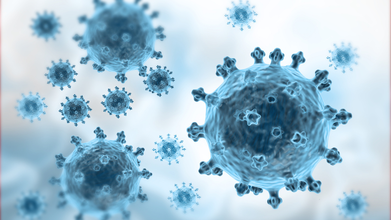- Health Conditions A-Z
- Health & Wellness
- Nutrition
- Fitness
- Health News
- Ayurveda
- Videos
- Medicine A-Z
- Parenting
Kollam Faces Chickenpox Outbreak: How To Recognize Symptoms Early

Credits: Canva
Kerala is on high alert as chickenpox cases are rising quickly in Kollam district. Over the past week alone, health authorities have confirmed more than 100 new cases, with numbers continuing to climb. This sudden spike has prompted officials to take swift action to prevent further spread. But why is chickenpox, often considered a seasonal illness, circulating now? And what early signs should you watch for to know if you or someone around you might have it?
Chickenpox Cases Surge Rapidly In Kollam
While chickenpox usually appears more often during the summer months, health officials say unpredictable weather during the rainy season is also playing a role in this surge. Authorities warn that the disease can lead to serious complications in children, teens, older adults, pregnant women, and people with weakened immune systems. Residents are being urged to follow preventive measures and seek medical attention promptly to contain the outbreak.
What Is Chickenpox And How Does It Spread?
Chickenpox, caused by the varicella-zoster virus, is extremely contagious and spreads through respiratory droplets or direct contact with someone who is infected. In children, it often starts as a mild rash accompanied by fever, but it can spread quickly in crowded areas.
The virus can also be transmitted through coughing or sneezing, and it is most infectious a day or two before the rash appears and in the early days of the rash. In individuals with weak immunity, the dormant virus may reactivate later in life, causing shingles (herpes zoster).
Why Is Kollam Facing A Chickenpox Outbreak?
The varicella-zoster virus spreads very easily through coughs, sneezes, or close contact with an infected person. Kollam’s warm, humid post-monsoon climate creates ideal conditions for the virus to multiply. While the first wave of cases was mostly among children, doctors now warn that adults are also increasingly vulnerable, according to The New Indian Express.
How To Detect Chickenpox Symptoms Early?
Spotting chickenpox early means looking for general warning signs like fever, fatigue, headache, and loss of appetite, which usually appear one to two days before the rash. The rash itself starts as tiny red spots that later form fluid-filled blisters and eventually scab over. Paying attention to these early symptoms—especially after known exposure—can help identify the infection sooner.
How To Spot The Chickenpox Rash
The first rash usually shows up as small red bumps on the face, chest, or back. These bumps quickly turn into blisters filled with fluid, which are contagious. Over a few days, the blisters break and crust over, forming scabs. It’s common to see spots, blisters, and scabs all at the same time, according to the CDC.
Stages Of Chickenpox
The Mayo Clinic explains that chickenpox progresses in three main stages:
- Incubation Stage (10–21 days): After exposure, the virus remains inactive. Infected individuals typically show no symptoms during this period.
- Prodromal Stage (1–2 days): Early signs include fever, tiredness, headache, loss of appetite, and body aches. This is also when the virus can start spreading to others.
- Rash Stage (5–10 days): Red, itchy spots appear first on the face and chest, spreading across the body. These spots develop into fluid-filled blisters that scab over within a few days. Mild fever, itching, and discomfort are common during this stage.
According to the Cleveland Clinic, complications are uncommon but can include pneumonia, brain inflammation (encephalitis), and bacterial skin infections. Vulnerable groups, such as infants, pregnant women, older adults, and people with weakened immunity are at higher risk of severe illness.
Is Air Pollution Causing Early Nearsightedness In Children? Expert Explains The Link

Credits: Gemini
For a long time, screens have taken most of the blame for declining eyesight among children. Doctors, however, are now drawing attention to another factor that often goes unnoticed: polluted city air.
Delhi continues to struggle with severe smog. On December 23, 2025, residents woke up to a thick blanket of haze as air quality worsened sharply across the capital. At 8 am, the average Air Quality Index stood at 414, placing it in the ‘severe’ category, according to data from the Central Pollution Control Board (CPCB). While toxic air is known to harm the lungs, skin, and heart, eye specialists are now observing a worrying trend. Children are developing myopia, or near-sightedness, at much younger ages, and the condition appears to be progressing faster than before.
As India faces some of the highest pollution levels in the world, new research is shedding light on how fine particulate matter, limited exposure to natural daylight, and ongoing eye irritation may be affecting the visual health of children growing up in urban areas. To understand this better, we spoke to Dr Rishi Raj Borah, Country Director, Orbis (India), who explained how air pollution may be playing a role.
Is Smog Affecting Children’s Vision?
Healthy eye development during childhood relies heavily on regular exposure to bright outdoor light. This light helps regulate dopamine release in the retina, which plays a key role in preventing the eyeball from growing longer than normal, a defining feature of myopia. Multiple studies have shown that children who spend more time outdoors are less likely to develop near-sightedness.
Although excessive screen use remains a concern, polluted air is now being recognised as an added risk. High smog levels can lead to:
- Eye irritation and redness
- Dry eyes and allergic inflammation
- Discomfort that discourages outdoor play
Explaining the connection, Dr Rishi Raj said, “With rising air pollution and high concentrations of PM2.5 in the environment, children may spend less time playing outside and more time on screens. Exposure to polluted air can also trigger inflammatory changes on the eye surface, reducing comfort and causing strain or irritation, especially in children.”
What Is Myopia?
Myopia, commonly known as near-sightedness, is a vision condition in which distant objects appear blurred because light entering the eye focuses in front of the retina instead of directly on it. This usually happens when the eyeball grows longer than normal. While close objects remain clear, far-off objects become difficult to see. Myopia often develops during childhood or adolescence and is typically managed with glasses, contact lenses, or, in some cases, surgery, according to the Cleveland Clinic.
How Is Smog Leading To Myopia In Children?
Smog may contribute to the development and progression of myopia by causing inflammation and oxidative stress within the eyes. This can damage ocular tissues, thin the sclera, and encourage axial elongation of the eyeball. Pollutants such as PM2.5 and nitrogen oxides (NOx) are small enough to affect eye tissues, triggering inflammatory responses and activating enzymes that break down collagen. Research cited on ScienceDirect.com also suggests these pollutants may interfere with dopamine pathways that help regulate eye growth, further speeding up myopia progression.
Highlighting the long-term risks, Dr Rishi Raj said, “When myopia starts at a very young age, it tends to worsen more rapidly over time. As vision continues to decline, the risk of serious eye conditions later in life, including retinal detachment, glaucoma, and myopic maculopathy, increases significantly. Early detection and timely management are therefore extremely important.”
How To Protect Children From Myopia?
Dr Rishi Raj suggests several practical measures parents can take to support their children’s eye health:
- Follow the 20-20-20 rule. Every 20 minutes, look at something 20 feet away for 20 seconds.
- Reduce recreational screen time and encourage frequent breaks.
- Make sure children get at least one to two hours of outdoor play each day, when air quality allows.
- Arrange regular eye check-ups, even if there are no obvious vision complaints.
- Ensure proper lighting and good posture during reading and screen use.
Doctors caution that if air quality continues to worsen and outdoor time keeps shrinking, India may see a sharp rise in childhood vision problems in the years ahead. While parents cannot fix pollution on their own, adopting healthier daily habits, staying alert to early signs of vision changes, and creating safer indoor environments can still go a long way in protecting a child’s eyesight in today’s polluted cities.
Air Pollution Is The Single Largest Health Risk In Delhi, Finds Study

Air Pollution Is The Single Largest Health Risk In Delhi, Finds Study
Delhi's air pollution continues to remain in the 'severe' category, and an analysis of Global Burden of Disease (GBD) 2023 found that in Delhi, 15% of all deaths are due to the air pollution. The study suggests that air pollution is city's single largest health risk. The deaths rose from 15,786 in 2018 to 17,188 in 2023.
Are Men Breathing In More Pollution?
Another study published in Scientific Reports, a five-year study titled Respiratory Deposition of Particulate Matter in Delhi: A Five-Year Assessment of Exposure Patterns and Health Risks tracked how particulate matter settles inside the respiratory system and found that men's exposure can be up to 1.4 times higher, especially while walking or commuting. The study noted that men on average spend more time outdoors while working, commuting, or walking in traffic-heavy areas. This leads to an increase in exposure.
Also Read: Barry Manilow Is Diagnosed With Lung Cancer At 82
Another reason is physiological, men have larger lung volumes, which means they inhale a greater volume of air with every breath. While women breathe slightly faster, the overall dose of pollution that settles in lungs tends to be higher in men because of how much air they inhale at once, and how long they stay outdoors.
While sitting, men inhale 1.5 times higher than women when it comes to PM2.5, and while walking, they absorb 1.2 times more than women. The same pattern is seen in PM10, while sitting, men record 1.34 times higher, and while walking, they inhale 1.15 times higher.
Delhi's AQI Today: On Tuesday, December 23, Delhi's AQI stood at 408 which is under the 'severe' category, around 5.30 am.
Read: British Man Compares Breathing In Delhi To Smoking 18 Cigarettes
Clean Air Is A Basic Right, Not A Luxury

This is happening in Delhi as we come closer to the festive time of Christmas. To draw attention to the continuously worsening AQI, National Students' Union of India (NSUI) representatives dressed as Santa Clause with gas masks. The NSUI volunteers walked in Santa Claus costumes, wearing gas masks to convey the message about Delhi's deteriorating air quality and growing public health emergency, and distributed face masks, candies, as well as handwritten notes that explained what exposure to polluted air can do to one's health. The NSUI representative also led an awareness walk and one of the office bearers said, "Santa represents joy, gifts and care for children. When even Santa needs a gas mask to survive in Delhi, it forces people to think about what kind of air our children are breathing."
“People already know the air is bad, but they have started accepting it as normal. Our effort is to remind everyone that this should not be normal," said another volunteer.
How To Read AQI?
As per the Central Pollution Control Board (CPCB), here is how you can know what your AQI stands for
- 0 to 50: Good
- 51 to 100: Satisfactory
- 101 to 200: Moderate
- 201 to 300: Poor
- 301 to 400: Very Poor
- 401 to 500: Severe
Air quality is made of dust and small particles like PM2.5 and PM10, along with gases like nitrogen dioxide from car exhaust, sulphur dioxide from factories, and carbon monoxide from vehicles. The levels are measured through specialized machines. In India, the standard of the machines are carried out by the CPCB.
This Mysterious New Virus Could Spread Faster Than Covid-19 And Flu

Credits: iStock
A new virus is going around the world, and experts say that it is stronger than COVID and flu. This has been termed as the new 'untreatable' mystery virus, and some even have warned that disinfectant cannot get rid of it.
This is the adenovirus, which exhibits same symptoms as a serious flu, including shortness of breath, a runny nose, and a sore throat. However, one difference is that this virus has lack of treatments. So for anyone who may have caught it, will have no other option but to "tough it out". However, the silver lining here is that in most cases, adenovirus is fairly mild, but if you are immunocompromised, then the symptoms could become more serious, reports the Mirror.
Eric Sachinwalla, Jefferson Health's medical director said that this virus is still unfamiliar and thus not much can actually be done to treat adenovirus. Speaking to PhillyMad, he said, "It is pretty contagious because it is heartier than other viruses - soap and water, or everyday disinfectant, won't kill it, so it tends to live in the environment longer."
Common Symptoms Of Adenovirus
- Shortness of breath
- Runny nose
- Sore Throat
- Diarrhea
- Pink eye
The good news is that for most part, these symptoms are manageable with rest. However, people who are more vulnerable, like the elderly, pregnant, or immunocompromised, may have to be more careful and keep a closer eye on their symptoms.
If the fever takes the body temperature to 40 Celsius, then it could be a serious situation, and you must consult your GP.
Read: Mystery Disease Adenovirus: New Virus Said To Be Stronger Than Covid And Flu — All You Need To Know
How Long Do The Symptoms Of This Mysterious Disease Last?
The symptoms usually start to subside within two days, however, if the symptoms stay even after three days without any relief, it might be a red flag. The best thing to do during such a situation is to go consult your GP.
What Is Adenovirus?
Adenovirus is a virus that has more than 60 different strains, which is why it is able to cause a variety of symptoms. Adenovirus refers to a group of common viruses that usually trigger cold- or flu-like illness. It spreads easily because it is far more resilient than many other viruses. Ordinary soap, water, and standard disinfectants do not reliably destroy it, allowing it to persist in the environment. As a result, infections often cluster in places where people spend time close together, such as daycares and military barracks. The virus spreads through the respiratory tract, can be shed in stool, and can survive for some time on contaminated surfaces, according to the CDC.
The reason for its spread right now is due to the surge of flu cases in the southern hemisphere which has influenced the outbreaks in the northern hemisphere. Another reason is the lower flu vaccinate rates, which has now made a large number of population more vulnerable to infections, overall, including adenovirus.
How Can You Stay Safe?
Since adenovirus spreads through close contact and is resistant to many everyday disinfectants, hygiene remains the key. The best way to stay safe is by avoiding close contact, especially with those who are unwell. You may also keep an eye on your symptoms, including your body temperature and take steps to prevent the virus from spreading by taking precautions, as well as getting the flu jab.
© 2024 Bennett, Coleman & Company Limited

